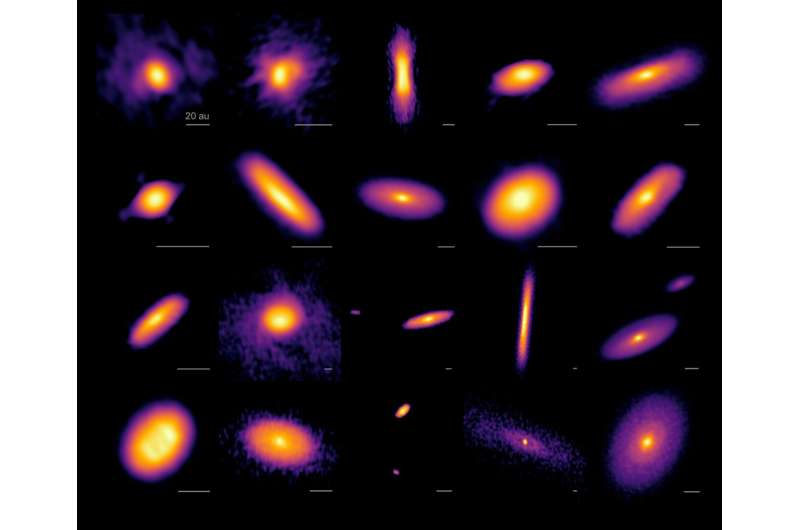This article has been reviewed according to Science X's editorial process and policies. Editors have highlighted the following attributes while ensuring the content's credibility:
fact-checked
peer-reviewed publication
trusted source
proofread
ALMA digs deeper into the mystery of planet formation

An international research team used the Atacama Large Millimeter/submillimeter Array (ALMA) to observe disks around 19 protostars with a very high resolution to search for the earliest signs of planet formation. This survey was motivated by the recent findings that planet formation may be well underway in the more-evolved proto-planetary disks, but until now there had been no systematic study to search for signs of planet formation in younger protostellar systems. Their research has been published in The Astrophysical Journal.
Planets form in a disk around a newborn star. These 'proto-planetary' disks only last a few million years, meaning that a forming planetary system only has this amount of time to finish its formation. However, it is still not clear just how rapidly planet formation begins within these disks.
Recent ALMA observations have revealed that many proto-planetary disks have substructures such as gaps and rings, indicating that planets are already forming from the disk. "These previous results motivated us to examine even younger disks around protostars to answer the question, at what stage of star formation do planet forms," says Nagayoshi Ohashi at Academia Sinica Institute of Astronomy and Astrophysics (ASIAA, Taiwan), who led the team.
The team observed disks around 19 protostars located within about 650 light-years from the Earth. This is the first systematic study to investigate the detailed structure of disks around a large sample of protostars with high angular resolution. The observations clearly show that the disks around protostars are different from more-evolved proto-planetary disks. Among the 19 protostars, rings, and gaps, which are signs of planet formation, were observed only in a few disks. Moreover, the ring structures are less distinct than those seen in the proto-planetary disks.
"We did not expect to see such clear differences between disks around protostars and more-evolved disks," says Ohashi. John Tobin, a Co-PI of the program at the National Radio Astronomical Observatory (U.S.) adds, "Our results suggest that disks around protostars are not fully ready for planet formation. We believe that the actual formation of the planetary system progresses rapidly in the 100,000 years to 1,000,000 years after star formation begins."
More information: Nagayoshi Ohashi et al, Early Planet Formation in Embedded Disks (eDisk). I. Overview of the Program and First Results, The Astrophysical Journal (2023). DOI: 10.3847/1538-4357/acd384
Zhe-Yu Daniel Lin et al, Early Planet Formation in Embedded Disks (eDisk). II. Limited Dust Settling and Prominent Snow Surfaces in the Edge-on Class I Disk IRAS 04302+2247, The Astrophysical Journal (2023). DOI: 10.3847/1538-4357/acd5c9
Merel L. R. van 't Hoff et al, Early Planet Formation in Embedded Disks (eDisk). III. A First High-resolution View of Submillimeter Continuum and Molecular Line Emission toward the Class 0 Protostar L1527 IRS, The Astrophysical Journal (2023). DOI: 10.3847/1538-4357/accf87
Yoshihide Yamato et al, Early Planet Formation in Embedded Disks (eDisk). IV. The Ringed and Warped Structure of the Disk around the Class I Protostar L1489 IRS, The Astrophysical Journal (2023). DOI: 10.3847/1538-4357/accd71
Miyu Kido et al, Early Planet Formation in Embedded Disks (eDisk). VII. Keplerian Disk, Disk Substructure, and Accretion Streamers in the Class 0 Protostar IRAS 16544-1604 in CB 68, arXiv (2023). DOI: 10.48550/arxiv.2306.15443
Journal information: Astrophysical Journal , arXiv
Provided by National Astronomical Observatory of Japan



















